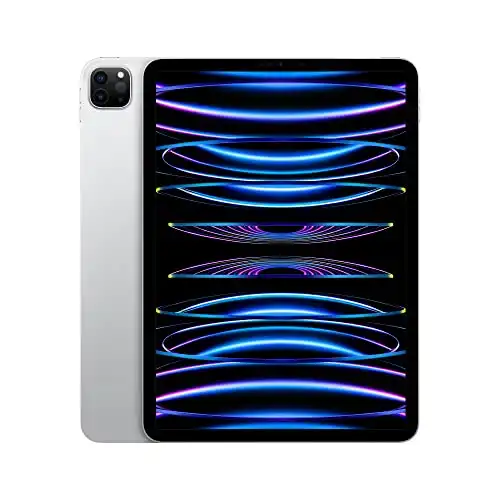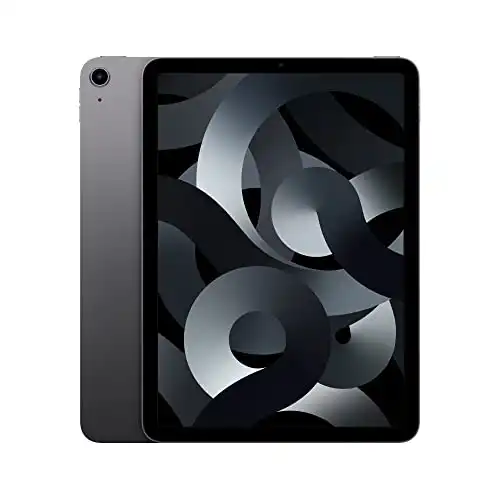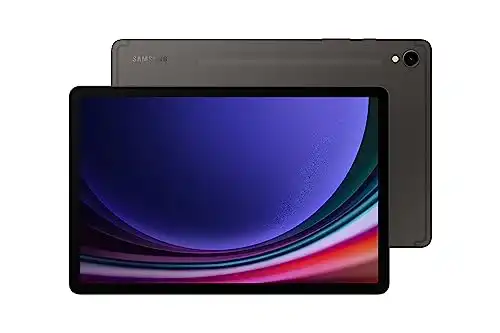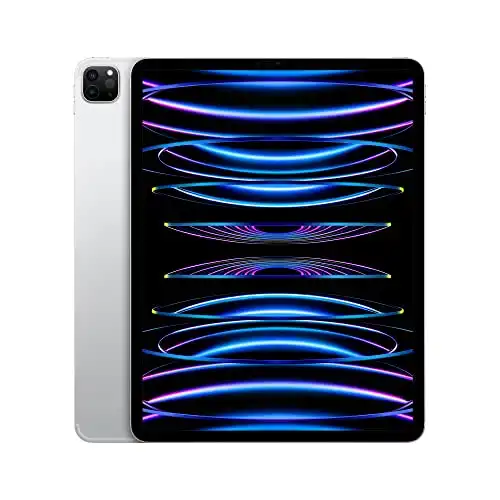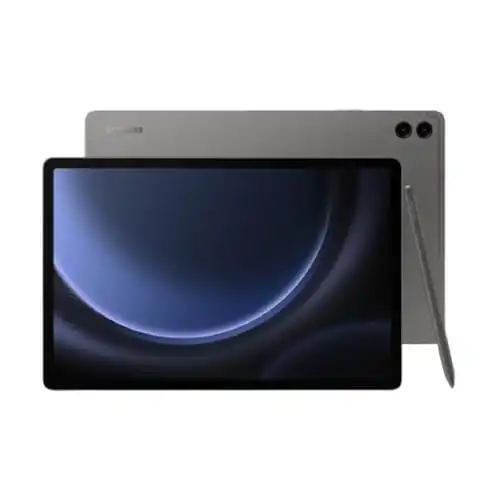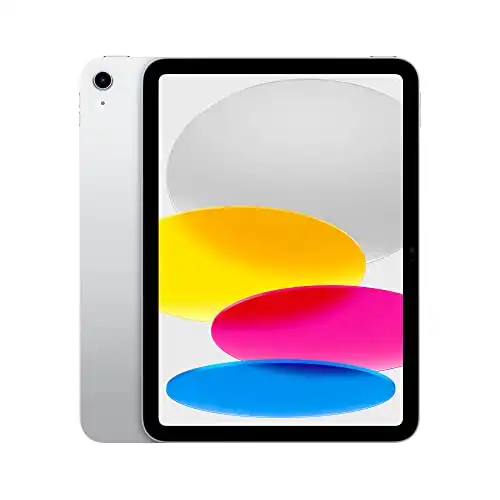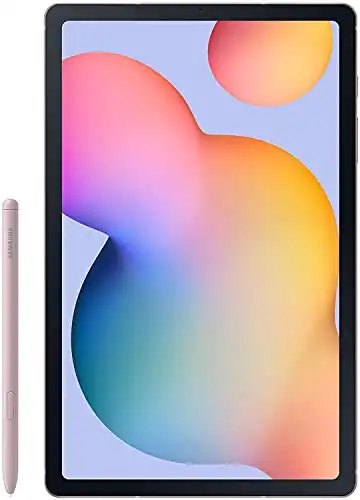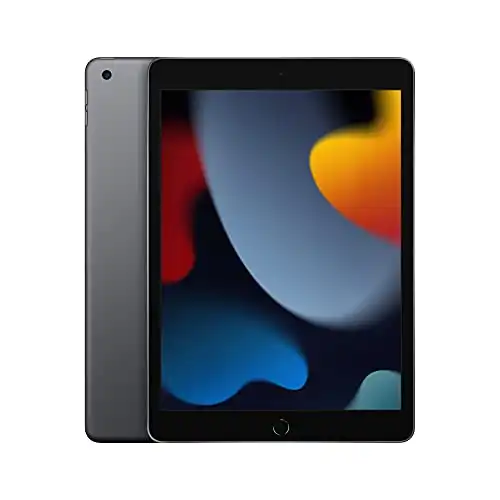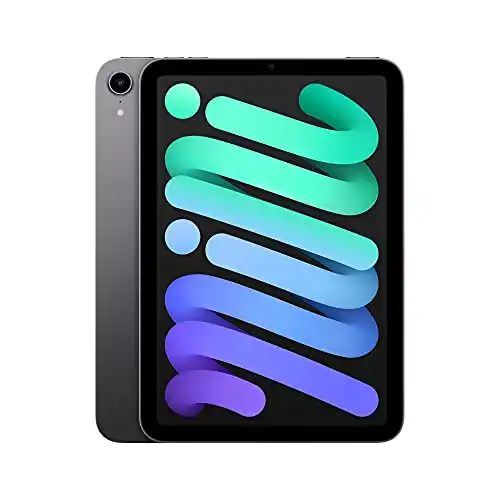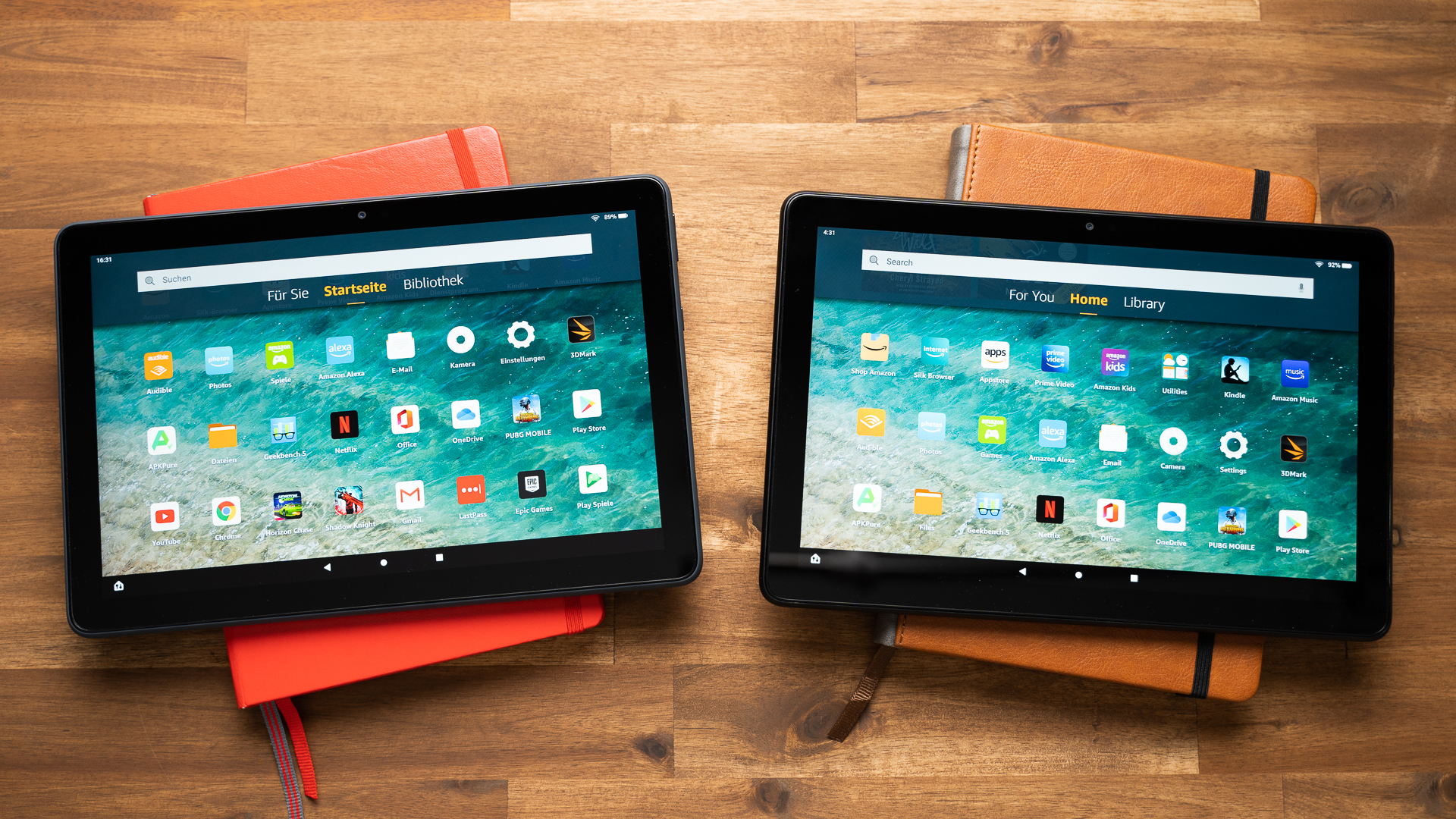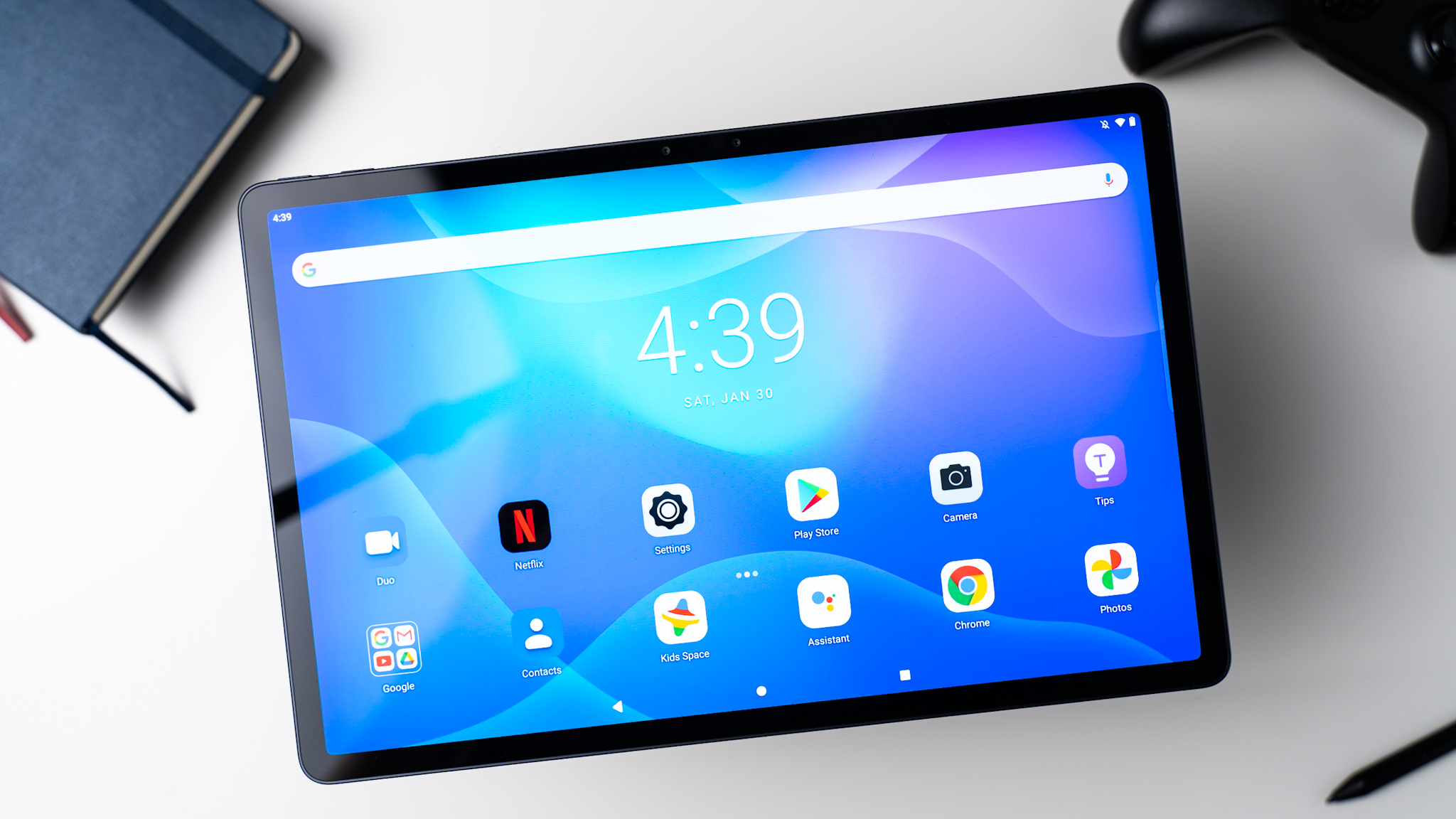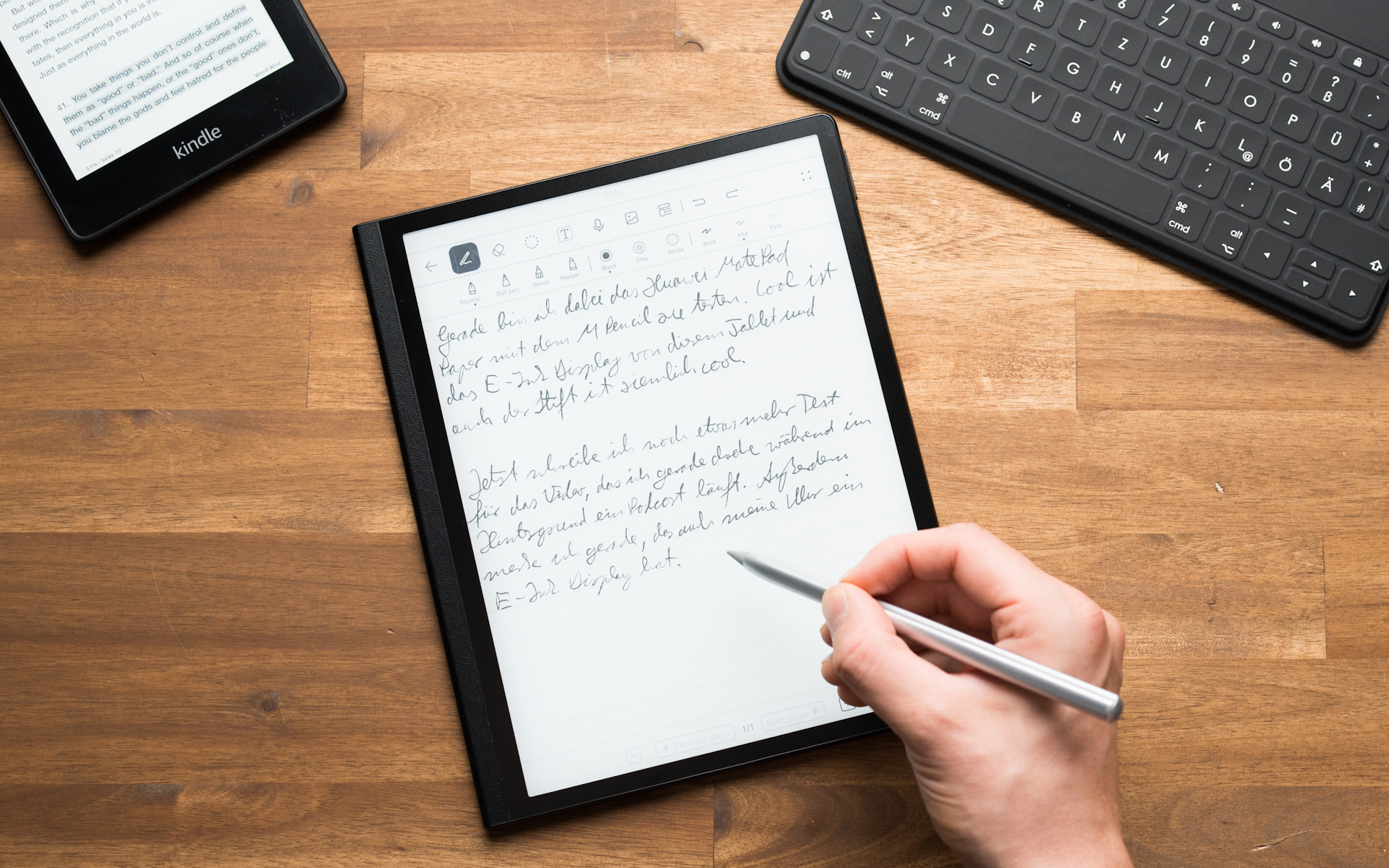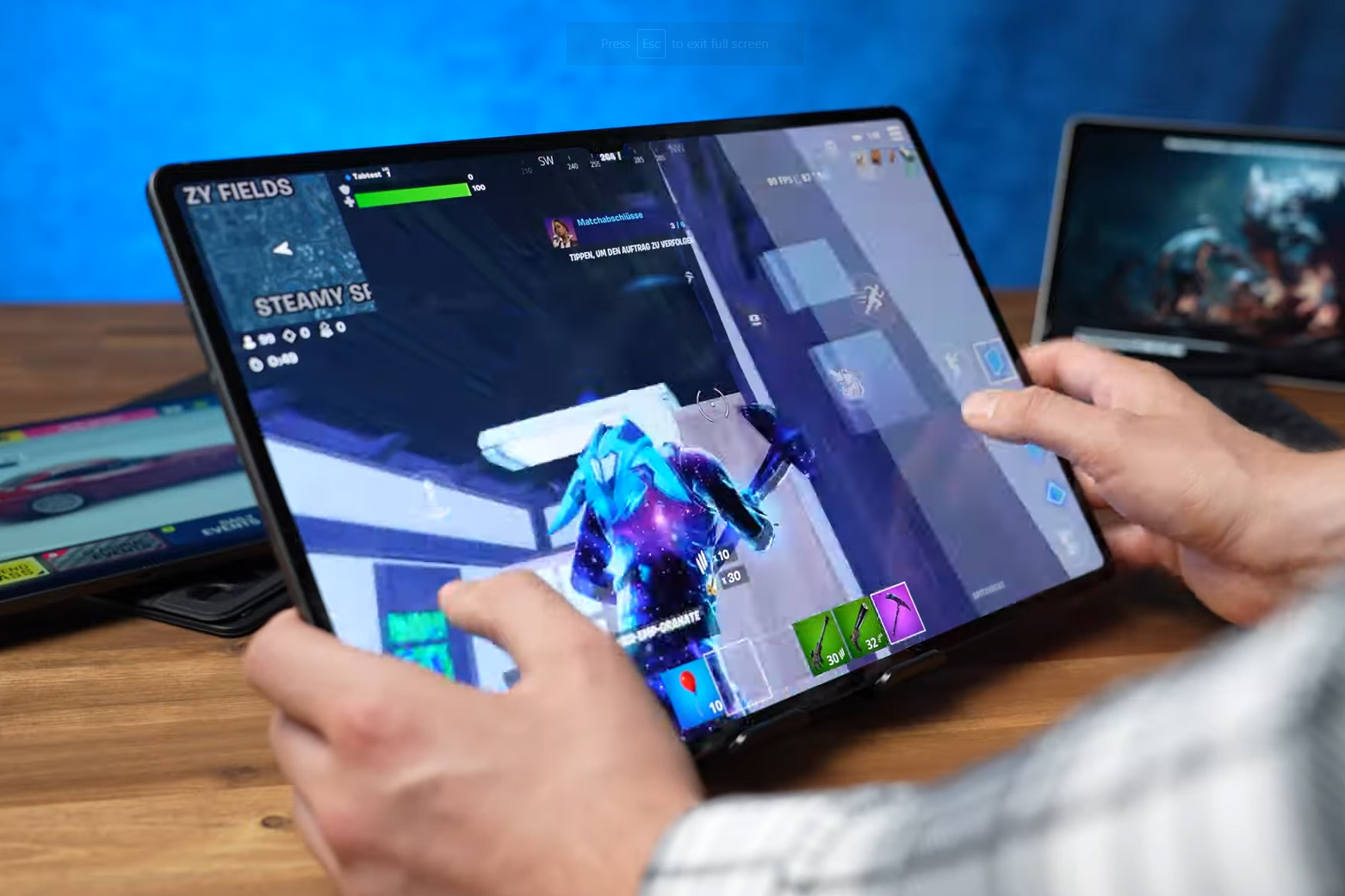Comparisons
iPad vs. Samsung Tablets: Which Side Should You Be On?
Should you get an Apple iPad or Samsung Galaxy tablet? Our comparison has the answers.
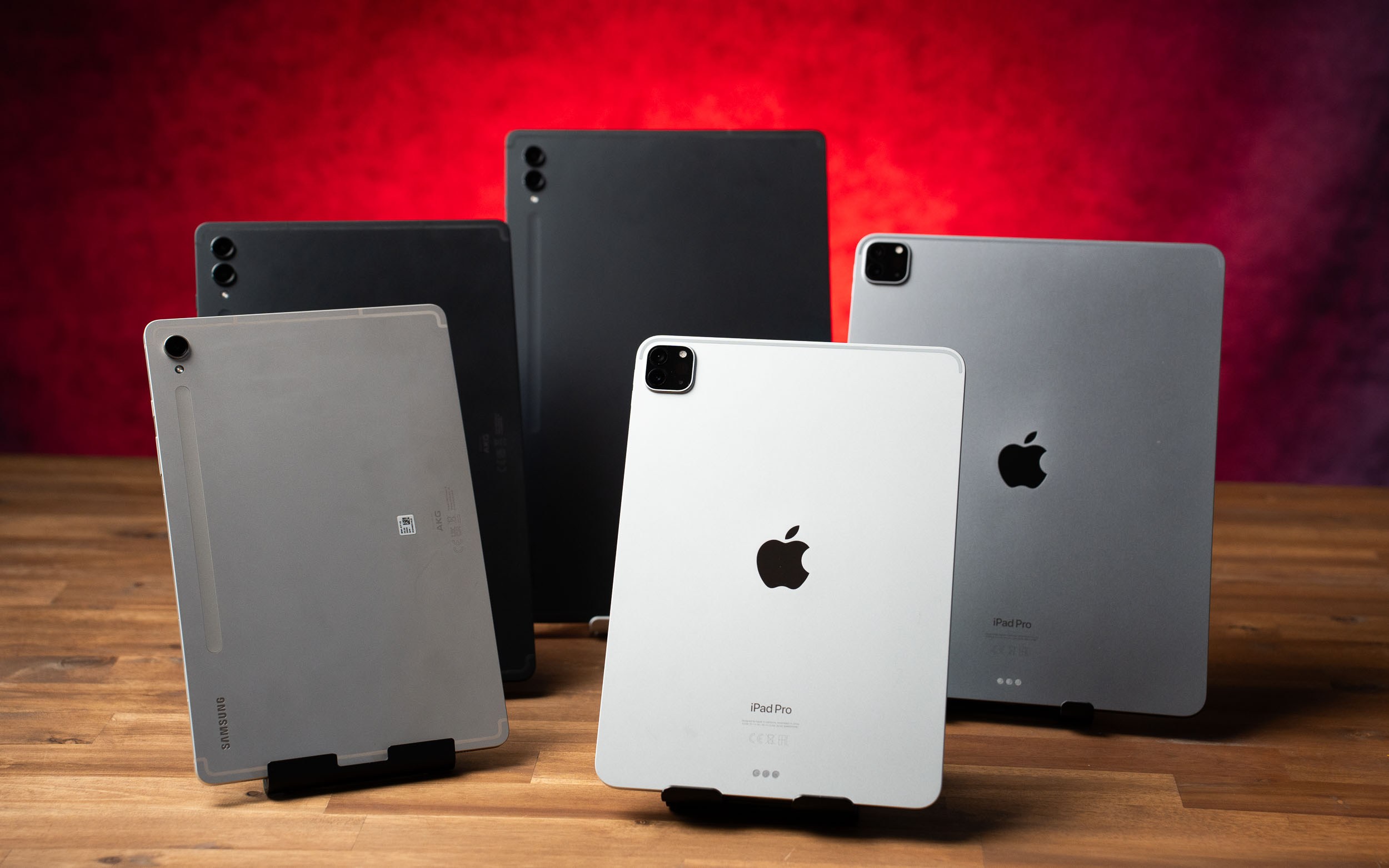
Two names dominate the tablet market: Apple and Samsung. These two giants of the tablet world offer a range of products, from premium flagship devices to affordable mid-range devices. Many users will have chosen their preferred manufacturer, but what if you’re still on the fence? Our iPad vs. Samsung tablets comparison is here to help you make the right choice.
iPad vs. Samsung Tablets: An Overview
- Biggest screen: Samsung Galaxy Tab S9 Ultra (on Amazon). The S9 Ultra has no equal in Apple’s lineup, with its 14.6-inch screen dwarfing the iPad Pro 12.9”. However, it comes at a cost of slightly reduced sharpness.
- Best performance: Apple iPad Pro 11” (on Amazon) and iPad Pro 12.9”(on Amazon). Apple’s flagship tablets have laptop-grade Apple M2 processors that are significantly faster than the best CPUs Qualcomm or Samsung can offer.
- Best screen: Samsung Galaxy Tab S9 (on Amazon) and Galaxy Tab S9+ (on Amazon). The 2X AMOLED screens on Samsung’s Galaxy Tab S9 tablets are significantly better than Apple’s IPS LCDs, with excellent contrast, vivid colors, and HDR10+ support.
- Best tablet for writing: Samsung Galaxy Tab S9 FE (on Amazon). Its 90Hz screen and included S Pen make it an ideal purchase for anyone who wants a tablet for writing—without the flagship prices of the full-fat Tab S9 tablets.
- Best gaming tablet: Apple iPad 10th Generation (on Amazon). The iPad 10 has fantastic gaming performance for the price, making it a great value purchase for dedicated tablet gamers.
- Best value: Apple iPad 9 (on Amazon). Apple’s previous-generation iPad has a dated design, but its still-strong CPU and Apple’s great long term support make it a valid purchase even now.
- Best compact tablet: Apple iPad Mini (on Amazon). Apple’s iPad Mini doesn’t have a direct competitor in Samsung’s lineup, making it the only choice for anyone seeking a sub-10-inch tablet.
Apple iPad Pro 11 and 12.9 vs. iPad Air vs. Samsung Galaxy Tab S9 and S9+
First, let’s start at the upper end of the price bracket and compare the flagship offerings from Apple and Samsung.
Apple’s two iPad Pro models, the iPad Pro 11” and iPad Pro 12.9”, essentially go head-to-head with the Samsung Galaxy Tab S9 and Galaxy Tab S9+. They have similar screen sizes and have similar prices. For example, the base iPad Pro 11” costs $799 in the US, as does the 11-inch Samsung Galaxy Tab S9.
The Apple iPad Pro M2 is the best tablet you can buy right now. It's more powerful than all competitors, has two very pretty 11-inch and 12.9-inch displays, as well as a premium built. We get great premium features like the good Apple Pencil 2, fantastic keyboard covers, facial recognition, and good speakers. However, compared to its predecessors, almost nothing has changed.
It’s a similar story with the larger models: the basic iPad Pro 12.9” costs $1099, while the equivalent Samsung Galaxy Tab S9+ (with its 12.4-inch display) costs $1199.
The Apple iPad Air is a bit of an outlier. It competes closest with the Samsung Galaxy Tab S9 spec-wise but has a price advantage. The base 64GB variant costs around $550, significantly cheaper than the 128GB Samsung tablet’s $799 MSRP. If you need more storage, you can get a 256GB iPad Air for $750, which is still slightly more affordable than the base Galaxy Tab S9.
The Apple iPad Air 5 is a fantastic premium tablet. It's cheaper than the iPad Pro but offers the same super-fast Apple M1 processor. We get a premium metal body, good speakers, a fingerprint scanner, two keyboard options, and the fantastic Apple Pencil 2. The 10.9 inch LCD screen is a good one but a bit darker than the Pro and supports 60Hz only.
Display
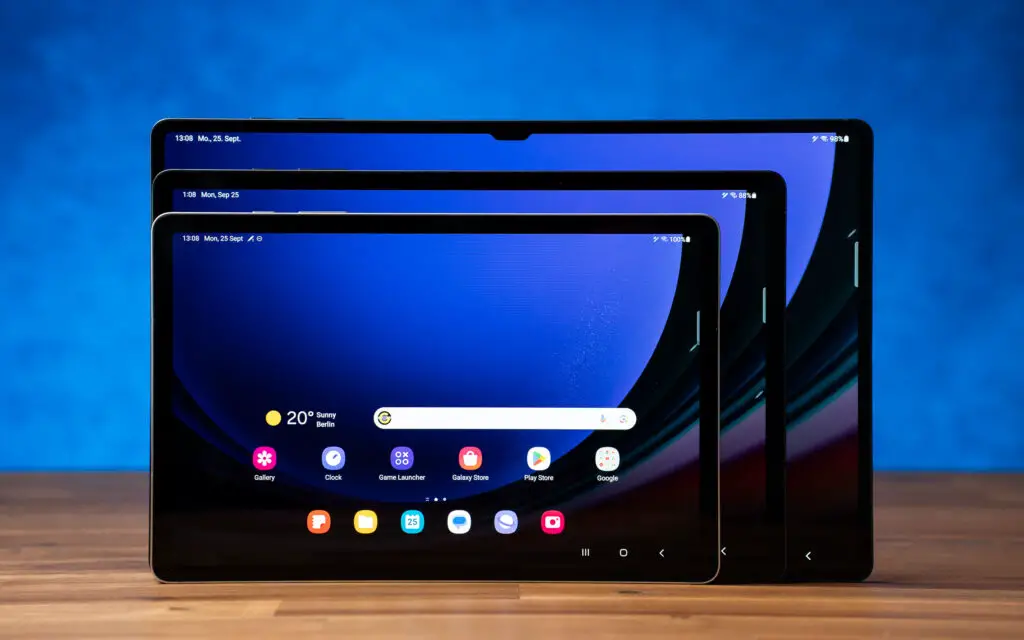
The Samsung tablets have one clear advantage over Apple’s products: the display. Apple uses IPS LCDs on the iPad Pro 11” and Air, while Samsung opted for 2X AMOLED panels for all the Galaxy Tab S9 tablets. This decision gives the basic Galaxy Tab S9 a considerable advantage over its direct rivals: AMOLED tech provides the Samsung with near-infinite contrast and inky blacks, as opposed to the greyish blacks you get on the iPad Pro 11 and iPad Air.
The Liquid Retina XDR display on the iPad Pro 12.9 has much better contrast than the iPad Pro 11” and iPad Air screens, thanks to its mini-LEDs. It compares surprisingly favorably to the AMOLED screen on the Galaxy Tab S9+, but it’s not quite there.
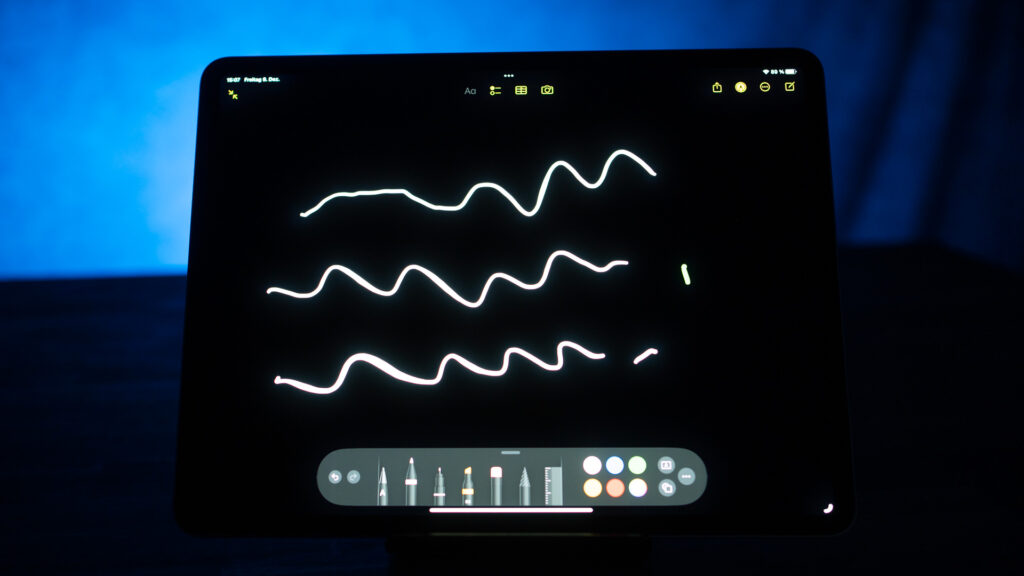
For example, the iPad Pro 12.9” display has blooming issues with high-contrast content. You’ll notice a subtle glow around the edges of bright areas. The Galaxy Tab S9+’s AMOLED screen has no such problems and will display high-contrast content perfectly.
The Apple iPad Pro 12.9-inch is the best 12-inch tablet on the market today. It features a super-fast Apple M2 chipset and has a very pretty Liquid XDR display with deep blacks. You can get it with the Apple Pencil 2 and an Magic Keyboard.
Samsung’s tablets also support HDR10+, while the iPad Pros “only” support HDR10. The iPad Air doesn’t support HDR at all.
Performance and Storage
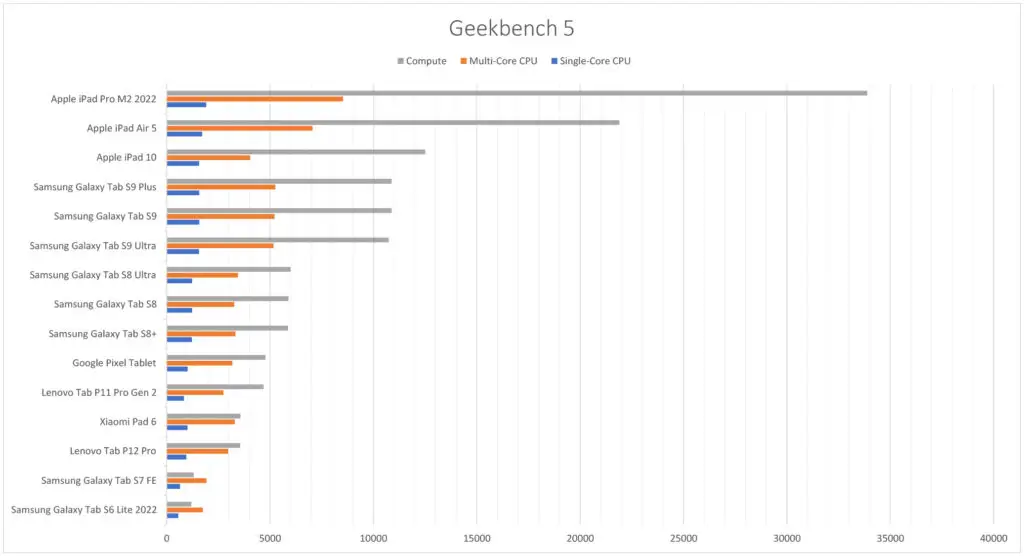
Unfortunately for Samsung, the script flips when we look at performance. Apple’s M2 CPUs are light-years ahead of the Qualcomm Snapdragon 8 Gen 2 CPUs in the Samsung tablets. Whether it’s Geekbench 5 or 3DMark, the Apple M2 and M1 in the iPad Pro and iPad Air measure significantly better than Samsung’s Snapdragon processor.
Does this matter in the real world? It depends. Your gaming experience will be almost the same; popular mobile games (such as PUBG Mobile, Fortnite, and Genshin Impact) will run at maximum settings without any significant framerate issues, regardless of tablet. The daily experience will also be similar, with a responsive OS and snappy app launches.
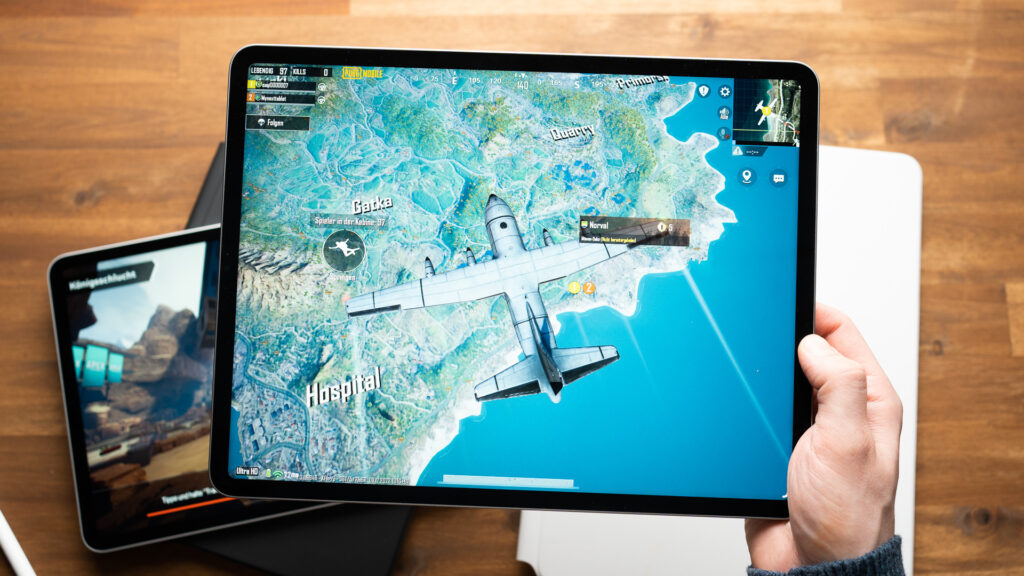
However, you will notice differences in some workloads. In our testing, the iPad Pro 12.9” rendered a 4K video to 1080p in just over half the time of the Samsung. The iPad completed the task in 1 minute 19 seconds, while the Samsung took 2 minutes and 10 seconds.
The storage situation is a mixed bag, with neither company taking the definitive upper hand. Apple has the advantage of sheer storage, with both iPad Pro models maxing out at 2TB. However, neither has a microSD slot. In contrast, the Samsung tablets max out at 256GB (S9) and 512GB (S9+) but support 1TB microSD cards. So, while neither tablet quite manages to reach the iPad Pros’ 2TB, they’re arguably much more flexible and can expand with your needs.
The iPad Air has 64GB or 256GB of storage, with no way to expand it via microSD.
Accessories
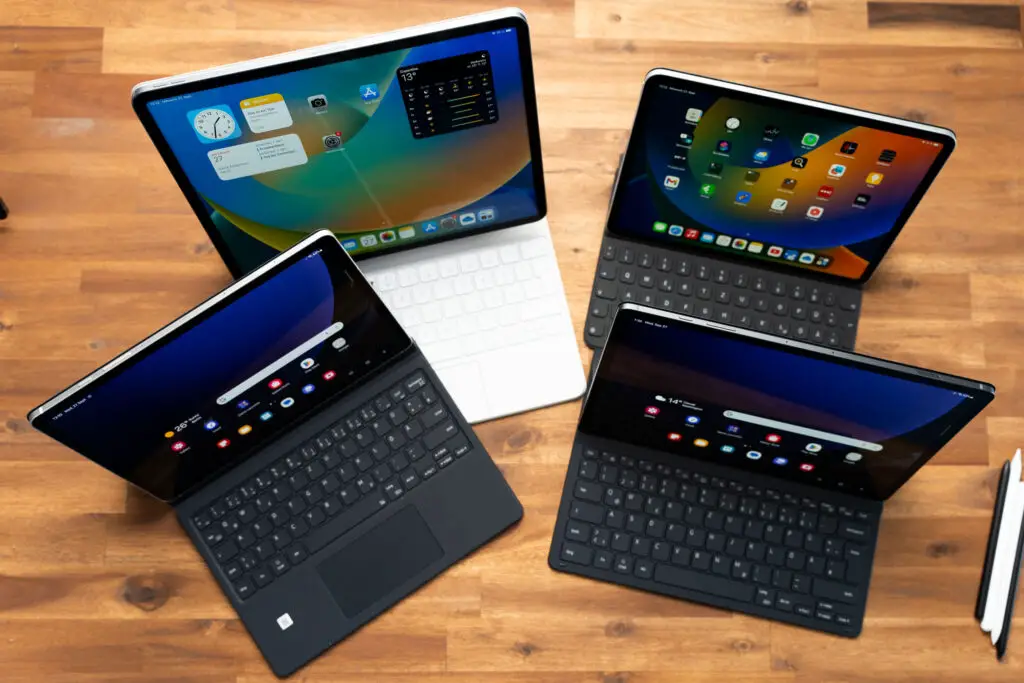
Apple and Samsung have great active styluses: the Apple Pencil 2 and Samsung S Pen, respectively. Both are great for writing and have impressive extra features such as top-notch “notes” apps, gesture support, and the ability to fill text boxes by writing. However, Apple charges around $100 for the Pencil 2, even on the priciest iPad Pro. In contrast, Samsung includes the S Pen with its Galaxy Tab S9 tablets.
It’s a similar situation with the keyboard covers from Apple and Samsung. Both companies sell two types of keyboard covers: a pricier laptop-style keyboard cover with a touchpad and a more compact one that forgoes the touchpad in exchange for a more affordable price. Both are great and very comparable with each other in price and performance.
And the Winner Is…
You can’t go wrong with an Apple iPad Pro, iPad Air, or Samsung Galaxy Tab S9; they’re all great tablets and well worth the money Apple and Samsung ask for. However, the Apple iPads all have a raw performance advantage over the Samsung tablets, which may come into play depending on your workload. Apple also offers much better long-term support than Samsung, which may help make the high sticker price more palatable.
If you’re platform-agnostic, we think the Apple iPads are the better buy. The iPad Air is especially appealing, given its impressive price. However, you shouldn’t feel short-changed if you want to stick to Google’s OS: the Samsung Galaxy Tab S9 and S9+ are excellent and compare favorably against Apple’s products in most areas. The included S Pen helps, too.
Check out our Samsung Galaxy Tab S9 vs. Apple iPad Pro comparison article for a more in-depth comparison.
iPad 10 vs. Samsung Galaxy Tab S9 FE
Now, let’s move down a notch and compare the two companies’ upper-midrange products, the Apple iPad 10 and Samsung Galaxy Tab S9 FE. Both are 10.9-inch tablets that cost around $450, although the Samsung comes with double the storage (64GB on the iPad vs. 128GB on the Samsung) for the same price.
The Samsung Galaxy Tab S9 FE is currently the best mid-range tablet with a pen. We get a pretty good overall package here with a high-resolution 10.9-inch 90Hz IPS display, a great design, latest software with long updates, and the S Pen, which is included. The S9 FE has many premium features such as a fingerprint reader, good speakers, and a water and dust-resistant body. It would be even better if the processor was more powerful. So, it's not a perfect gaming tablet.
- Premium design
- IP 68 certification
- Pretty 90Hz display
- Fingerprint reader
- Up-to-date software
- Good speakers
- S Pen is included
- Good keyboard cover
- Performance just average
Display
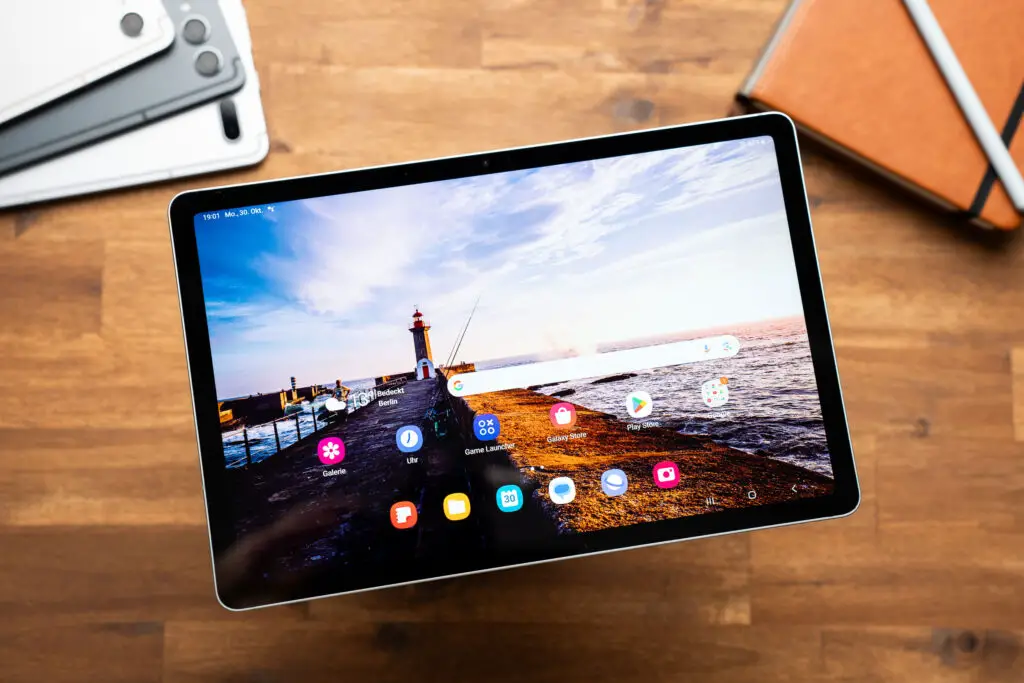
Even at this lower price point, Samsung still holds the advantage over Apple in the display stakes. While you don’t get a 2X AMOLED screen on the Tab S9 FE, the Samsung tablet has a 90Hz display with a fully laminated construction.
In contrast, Apple still only has a 60Hz screen on the iPad 10, complete with an annoying air gap between the LCD and glass due to a non-laminated design. While the iPad 10’s screen is far from bad, it’s certainly a step behind the smooth 90Hz refresh rate of the Samsung tablet.
The iPad 10 also has an issue with jelly scrolling in landscape mode. Jelly scrolling is an issue where one side of the display refreshes faster than the other, leading to an uneven image akin to a rolling shutter effect. In contrast, the Galaxy Tab S9 FE has no such issues with its display.
Colors, contrast, and sharpness are broadly similar between the two displays. So, if you’re not too concerned about refresh rate or the air gap, you’ll be happy with the iPad 10’s screen. That said, I’d take a higher refresh rate display any day of the week.
Performance and Storage
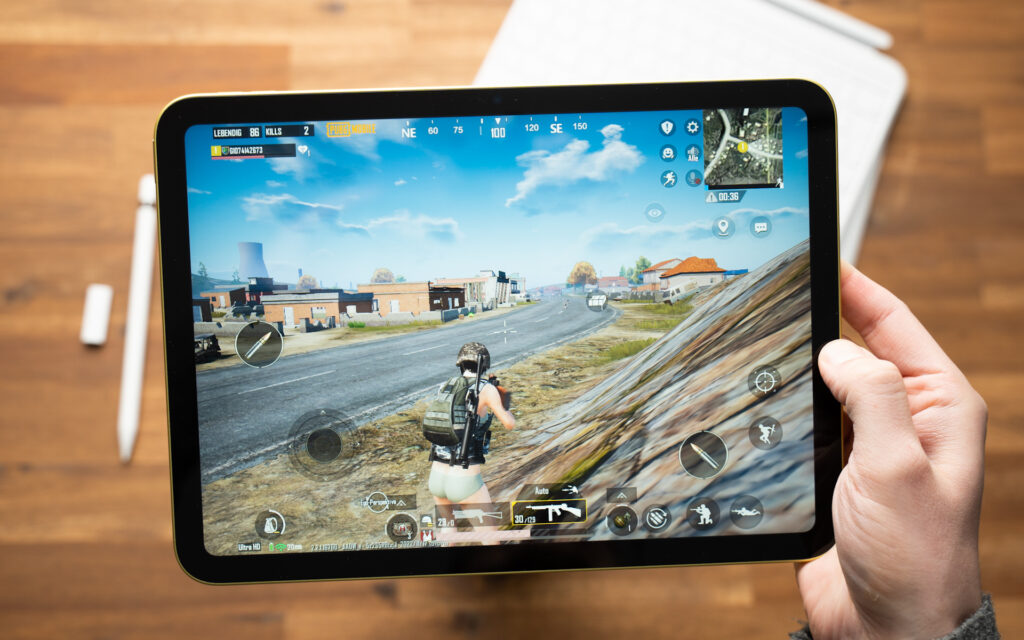
There are no surprises here: the Apple iPad 10 handily bests the Samsung Galaxy Tab S9 FE in the performance stakes. The Apple A14 Bionic in the iPad 10 isn’t as fast as Apple’s M-class silicon, but it only has to go up against a mid-range CPU in the S9 FE’s Exynos 1380. There’s no contest here.
The Apple iPad 10 is faster than all Android tablets. Especially compared to its predecessor, it offers a better and more modern design, a bit lager and bright 10.9-inch display, as well as a new and good keyboard cover. Overall, it's a great tablet but it does have a bunch of downsides. The screen is not laminated and I noticed a jelly effect. You can get it with the first-generation Apple Pencil. However, for that one to work you have to buy an extra adapter which is ridiculous. And, sadly, the price has increased.
You’ll notice the performance difference in real-world situations, too. For example, the iPad 10 runs games like Apex Legends and Fortnite at maximum settings without any issues and little slowdown. In contrast, the Galaxy Tab S9 FE requires you to reduce graphical settings in games like Fortnite; even then, you’re looking at drops to 30FPS in busy areas. You’re still getting playable performance, but it’s not as smooth as the iPad 10.
However, if storage is more of a priority than outright performance, you’ll likely prefer the Samsung. The Apple iPad 10 has 64GB or 256GB of storage, while the Galaxy Tab S9 FE comes in 128GB and 256GB variants. The Samsung also has expandable storage via a microSD card slot, so you can add even more storage if necessary.
Accessories
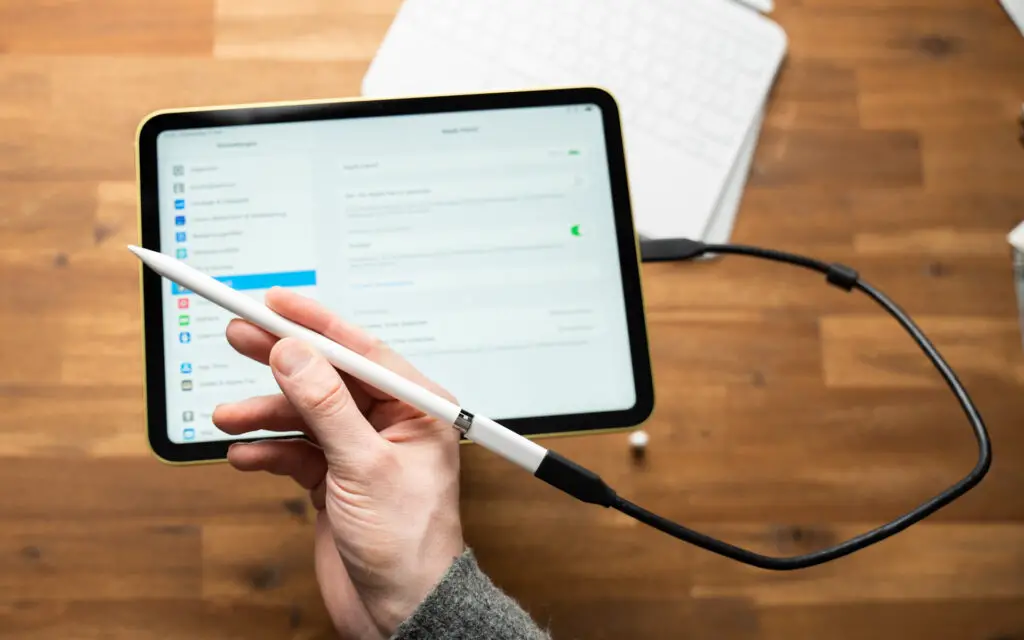
The Apple iPad 10 and Samsung Galaxy Tab S9 FE both support active styluses: the Apple Pencil 1 (or USB-C) for the iPad and the Samsung S Pen for the Tab S9 FE. The writing experience is almost as good as on higher-end tablets, only lessened by the lower refresh rates on both tablets.
But the iPad 10 has one major issue: the adapter problem. You’ll either have to use a USB-C to Lightning adapter to use a Pencil 1 or opt for the Pencil USB-C and its lack of pressure sensitivity. You can’t use the Apple Pencil 1 wirelessly with the iPad 10.
Read: Apple Pencil 1 vs 2 vs USB-C Guide
Samsung’s S Pen, on the other hand, works flawlessly with the S9 FE. No clunky adapters or compromises here. And, like on the full-fat Galaxy Tab S9, Samsung includes an S Pen with every Tab S9 FE.
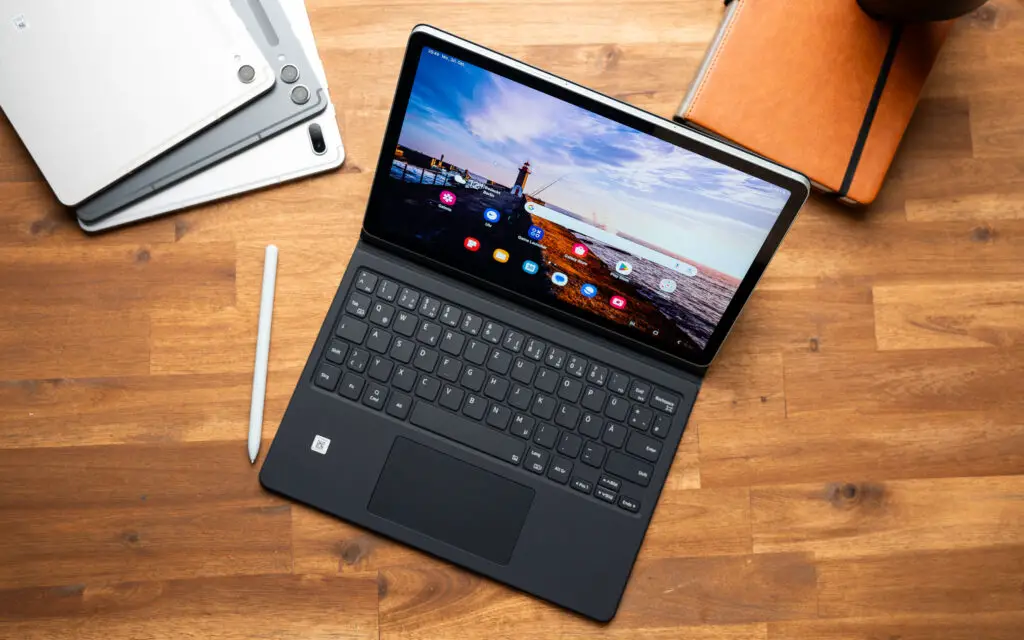
Despite being a lower-end product in the stack, the Galaxy Tab S9 FE is 100% compatible with the high-quality keyboard covers Samsung designed for the Galaxy Tab S9. So you get two models, the basic keyboard cover and the trackpad-equipped Book Cover Keyboard. In contrast, the iPad 10 only supports its specific keyboard cover—the Magic Keyboard Folio—and isn’t compatible with the iPad Air or iPad Pro keyboards.
Which Is Best?
If you want a high-performance tablet in this price range, the Apple iPad 10 is the easy winner. It has issues but runs rings around the Samsung Galaxy Tab S9 FE in synthetic and real-world performance scenarios. However, what if you only need a tablet for daily use and content consumption and don’t plan to game? In that case, the Samsung tablet’s better display, expandable storage, and better stylus experience may give it the edge.
Apple iPad 9 vs. Samsung Galaxy Tab S6 Lite 2022
The Apple iPad 9 and Samsung Galaxy Tab S6 Lite 2022 are two solid mid-range products, with the iPad’s 10.2-inch screen going up against the Samsung’s 10.4-inch display. Both come in at a similar price, too: the iPad costs $329 while the Samsung will set you back slightly more, with a $349 MSRP.
If you’re choosing between Apple and Samsung at this price bracket, these are the two tablets you’ll be considering.
Display
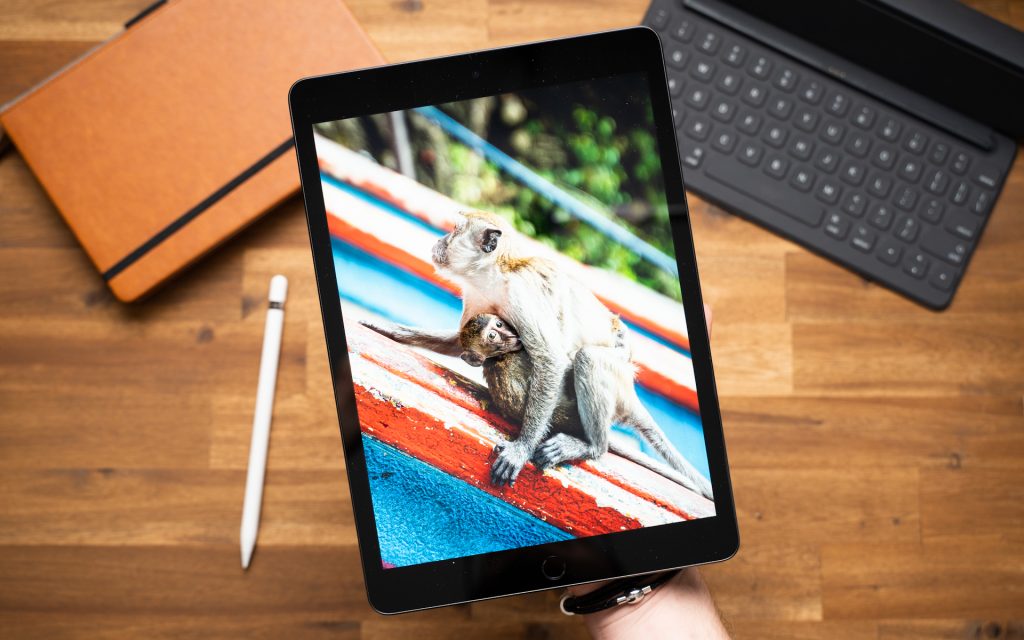
Unlike comparisons higher up the product stack, the Apple iPad 9 and Samsung Galaxy Tab S6 Lite 2022 are mostly evenly matched in terms of their displays. Both are 60Hz and have comparable sharpness, with the choice between the two coming down to your priorities. The Samsung has a laminated construction with no air gap, which is much preferable to the non-laminated design of the iPad 9’s screen.
On the other hand, the iPad 9’s display has higher maximum brightness than the Samsung’s. It’s also an IPS LCD panel, meaning better viewing angles than the Samsung tablet’s TFT LCD. However, the real-world advantages aren’t quite as noticeable, as the Samsung still has wide viewing angles and great colors.
The iPad 9 has the technically better display, but the Samsung Tab S6 Lite 2022 isn’t bad—especially at this price.
Performance and Storage
Apple’s performance lead extends even further here. Despite being a $300 tablet, the iPad 9 still packs a top-notch CPU in the Apple A13 Bionic. Sure, it’s old news by now, but it’s still significantly faster than the Qualcomm Snapdragon 732G or 720G you find in the Galaxy S6 Lite 2022.
For example, the Samsung tablet can only run Fortnite smoothly at the lowest settings. PUBG Mobile goes one step further, limiting you to the “HD” graphics preset to ensure decent performance. In contrast, the Apple blazes through Fortnite and PUBG Mobile at the highest graphics presets with smooth framerates and no hiccups. As far as performance goes, these two tablets are worlds apart.
Storage options are identical between the two tablets. The base models come with 64GB of RAM, with a higher-priced 128GB variant also available. However, the Samsung tablet has a microSD card for storage expansion.
Accessories
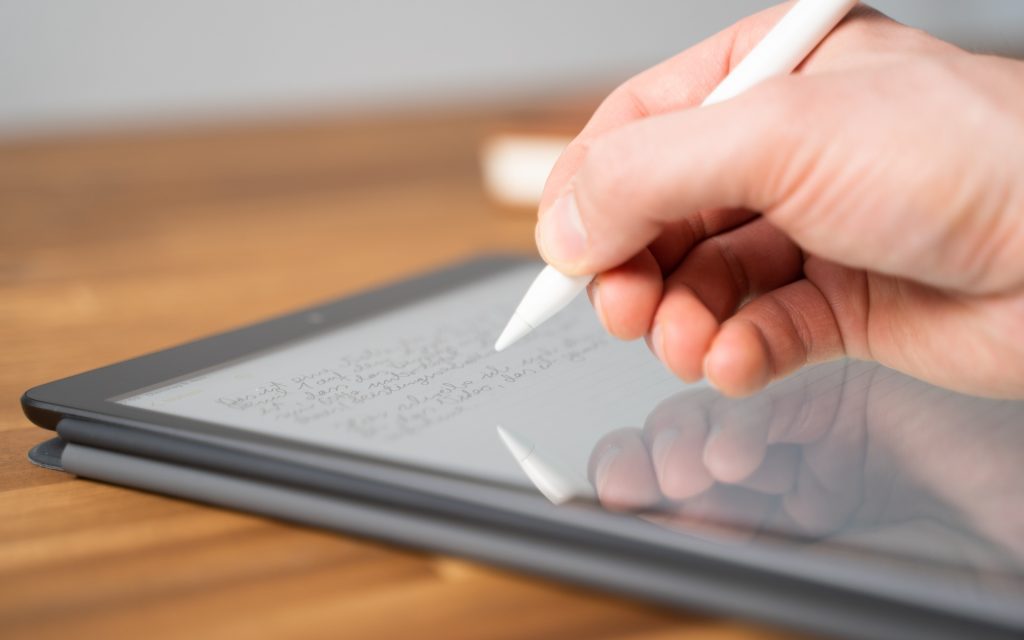
Like the higher-end tablets, the iPad 9 and Galaxy Tab S6 Lite 2022 support active styluses. The iPad 9 works with the Apple Pencil 1, while the Tab S6 Lite 2022, as usual, supports the Samsung S Pen. Both are great pens with solid software support. Samsung includes the S Pen with the Galaxy Tab S6 Lite 2022, while the iPad 9 requires you to purchase the Pencil 1 separately.
Keyboard covers are available for both tablets, although only Apple currently sells an official first-party keyboard cover for its tablet. The Apple Smart Keyboard is an older design that lacks a trackpad, but its affordable (by Apple standards) price makes up for it somewhat.
Samsung Galaxy Tab S6 Lite 2022 owners must buy third-party keyboard covers, as Samsung doesn’t sell an official one. Thankfully, there are a lot of choices on online retailers like Amazon.
A Clear Choice
The Apple iPad 9 is slightly cheaper and significantly faster than the Samsung Galaxy Tab S6 Lite 2022, making it the better buy here. Sure, it has a slightly smaller display, but it’s only by 0.2 inches, which isn’t enough to be a true dealbreaker.
The value of the Apple iPad 9 is fantastic. Because of its Apple A13 processor it is faster than every premium tablet running Android right now. We also get a great built quality, a solid screen, up-to-date software, Apple Pencil support, and the TouchID fingerprint scanner. Sadly, the design looks a bit outdated and the display continues to be not laminated.
So, unless you’re a die-hard Android fanatic (or are a heavy stylus user), the Apple iPad 9 is the easy winner in this comparison.
What About the iPad Mini?
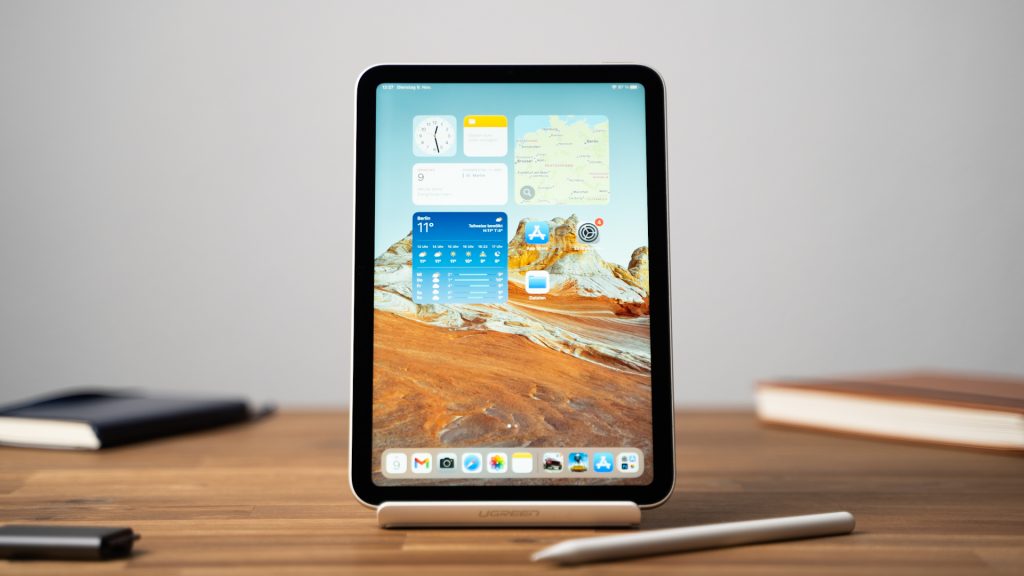
The Apple iPad Mini is a great compact tablet, but Samsung doesn’t offer a direct competitor. While the Korean giant does sell two 8-inch tablets in the form of the Samsung Galaxy Tab Active 5 and Galaxy Tab A9, neither is a genuine rival to the iPad Mini.
The Apple iPad Mini 6 is the best 8-inch tablet on the market today. It offers a premium design, is more powerful than every Android tablet, supports the Apple Pencil 2, and ships with up-to-date software. We get premium features like great speakers and a fingerprint scanner. Sadly, the otherwise excellent 8.3-inch screen has a jelly effect which is a bit of a bummer.
- Premium design
- Very powerful
- Good speakers
- Fingerprint scanner
- Apple Pencil 2 support
- Up-to-date software
- Display has jelly effect
- No phone capabilities
The Galaxy Tab Active 5 is a rugged tablet focused on durability in rough conditions, so it has a different design ethos than the iPad Mini. Similarly, the Galaxy Tab A9 is an entry-level tablet that doesn’t come close to the iPad Mini in performance or overall quality. You have to look beyond Samsung if you want an Android rival to the iPad Mini: namely, the Lenovo Legion Tab Y700.
Read: iPad Mini vs. Lenovo Legion Y700 2023
Conclusion
Apple’s iPads all hold noticeable performance advantages over their Samsung counterparts, making them the tablets to go for if performance is your priority. Even if it isn’t, Apple’s great software support (expect 8 or 9 years of software updates!) makes them compelling options for longevity and long-term security.
However, Samsung’s tablets are all still good-to-great devices that are worth considering. Sure, only the highest-end Galaxy Tab S9 and S9+ really go toe-to-toe with their Apple counterparts, but they all have something to offer—especially if you prefer Android.
Need help narrowing your choices down even further? Check out our Apple iPad Pro 11” vs. iPad Pro 12.9” comparison.
If you have bought a Samsung, why not find out everything you need to know about using Androids?
-
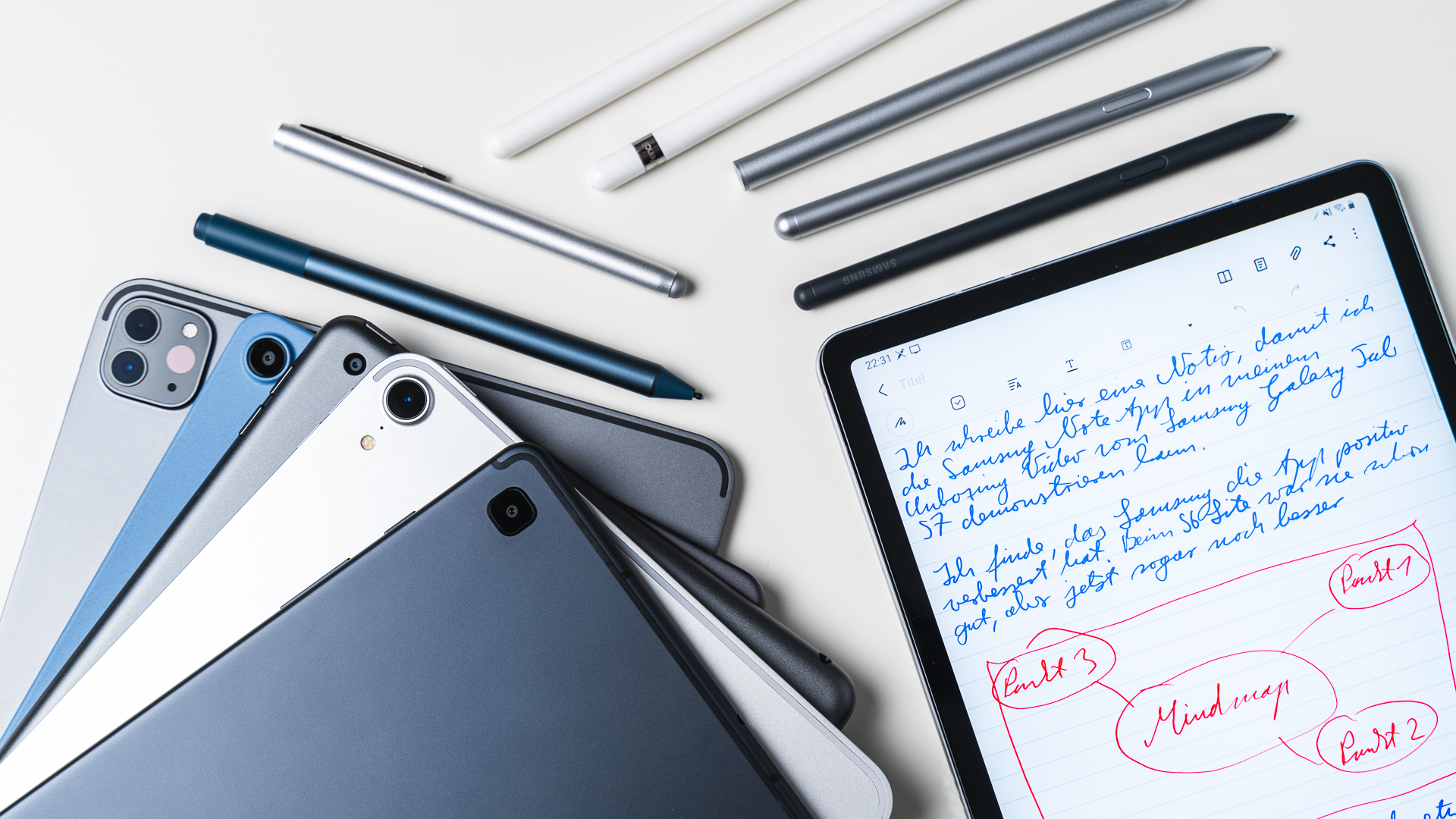
 The Best6 months ago
The Best6 months ago9 Best Tablets With Stylus Pen For Drawing & Writing | 2024 Edition
-
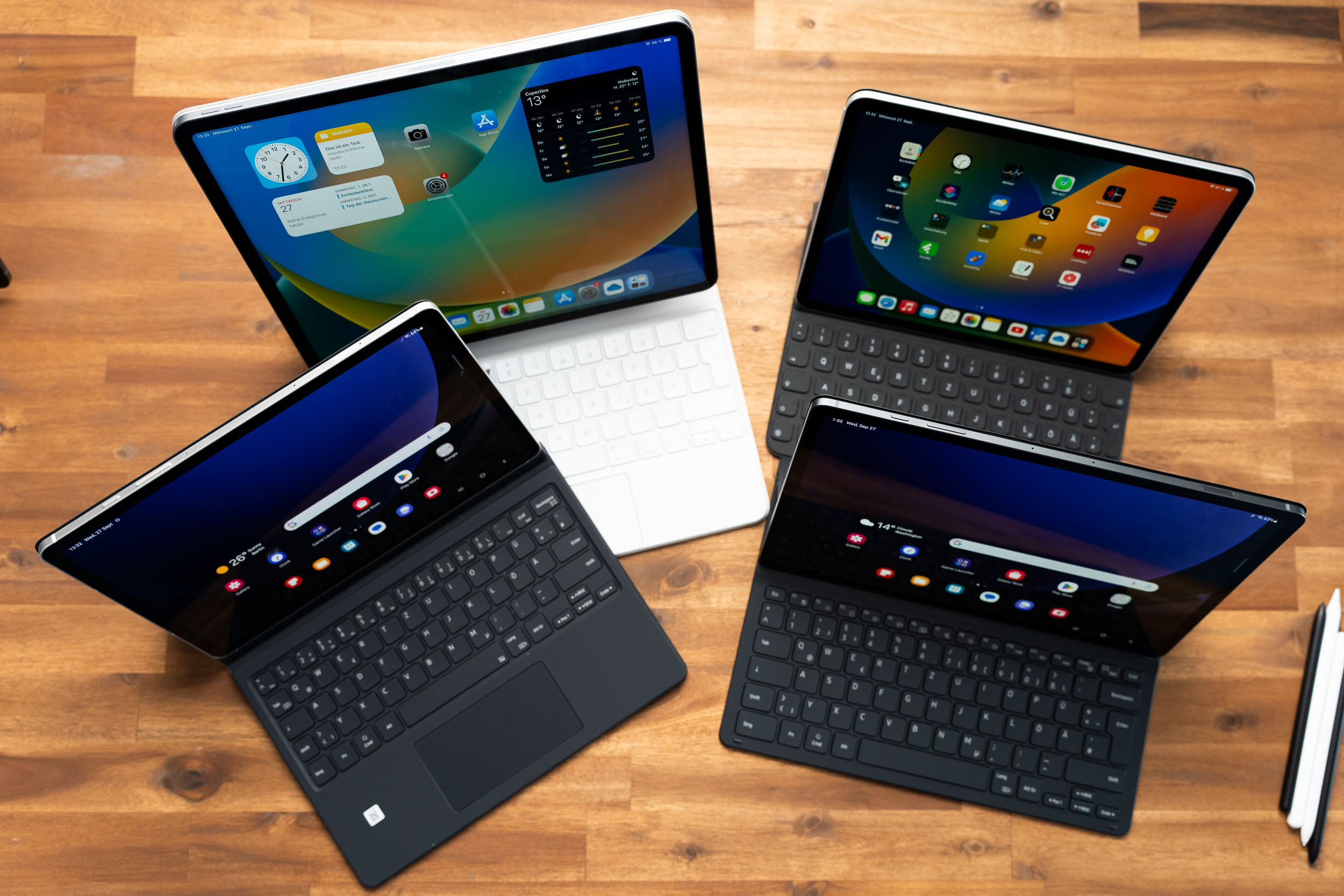
 The Best5 months ago
The Best5 months agoTop 10 Best Tablets with a Keyboard | 2024 Edition
-
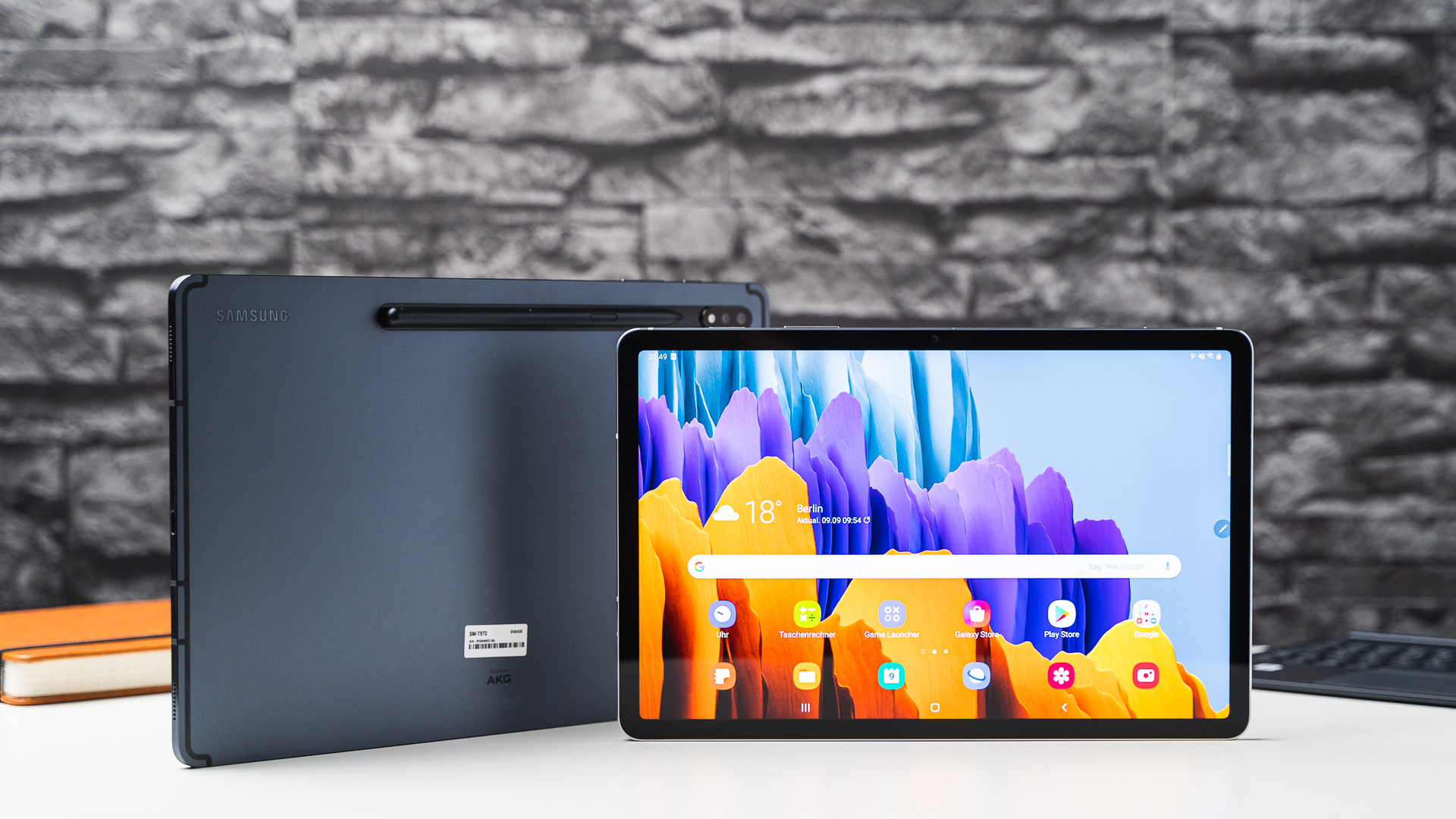
 The Best4 months ago
The Best4 months agoTop 15 Best Android Tablets Based On Real Reviews | 2024 Edition
-
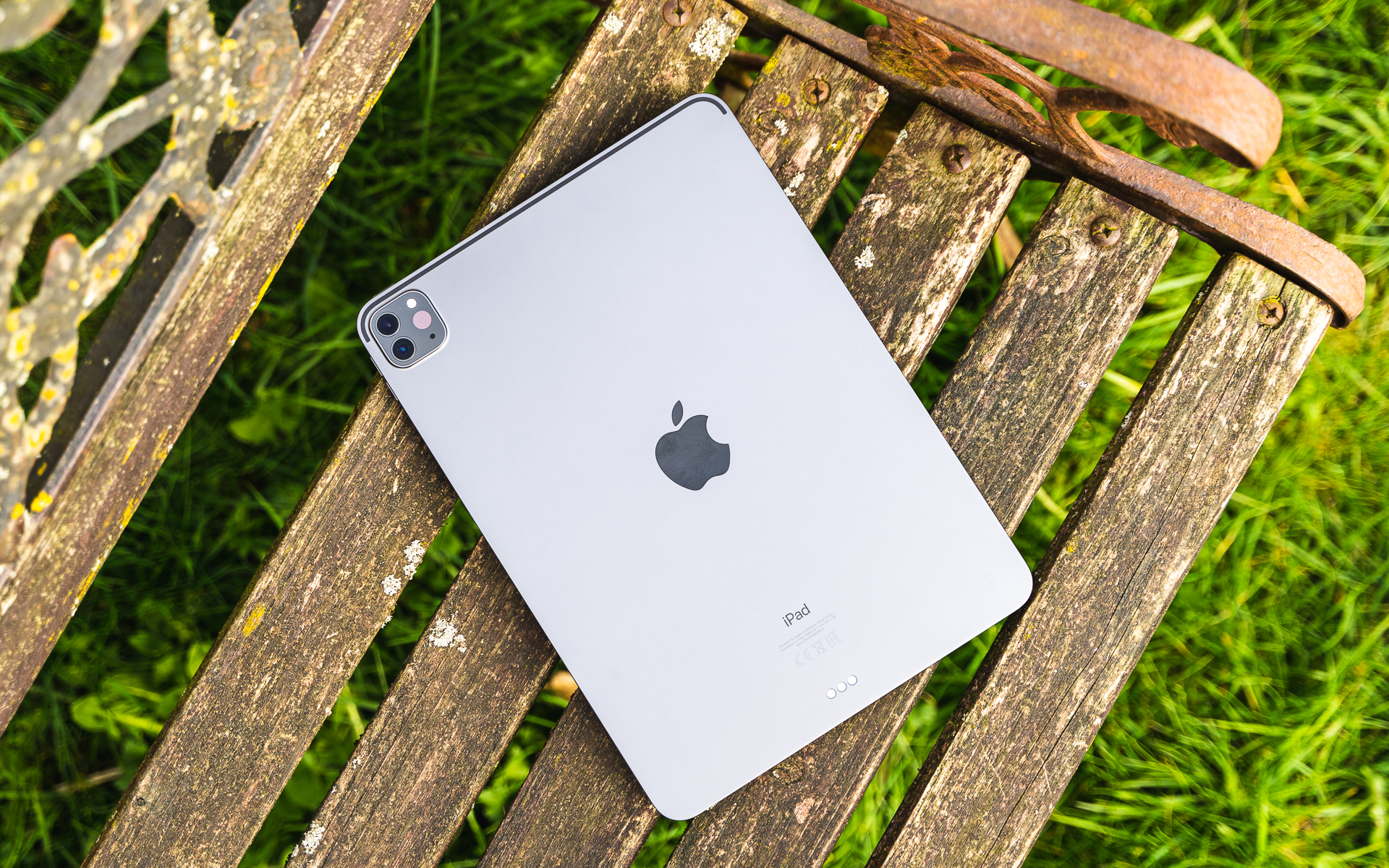
 The Best4 months ago
The Best4 months ago11 Best Tablets With 5G, 4G LTE & SIM Card Slot in 2024
-
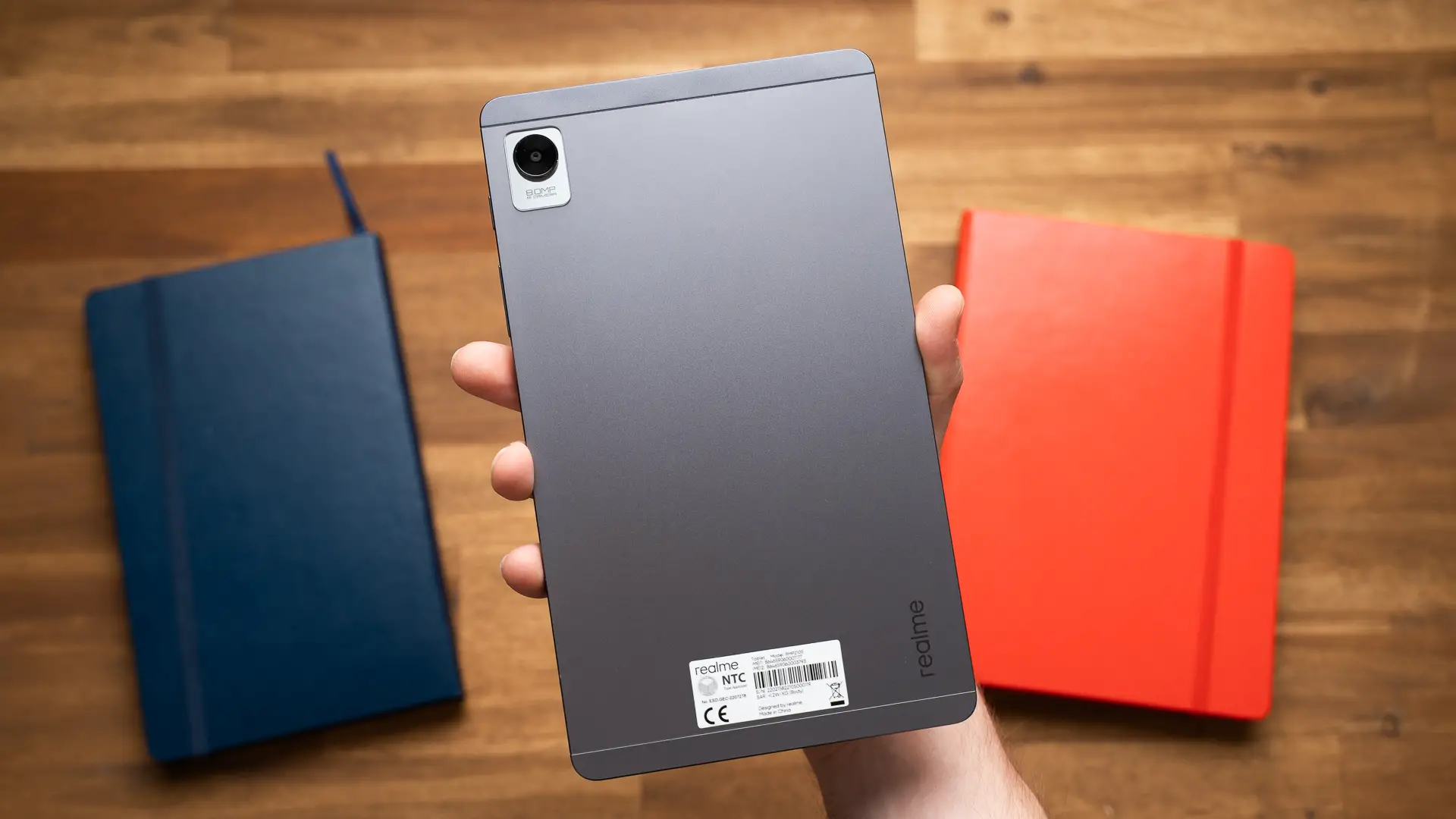
 The Best4 months ago
The Best4 months ago6 Best 8-Inch Mini Tablets Review & Comparison | 2024 Edition
-
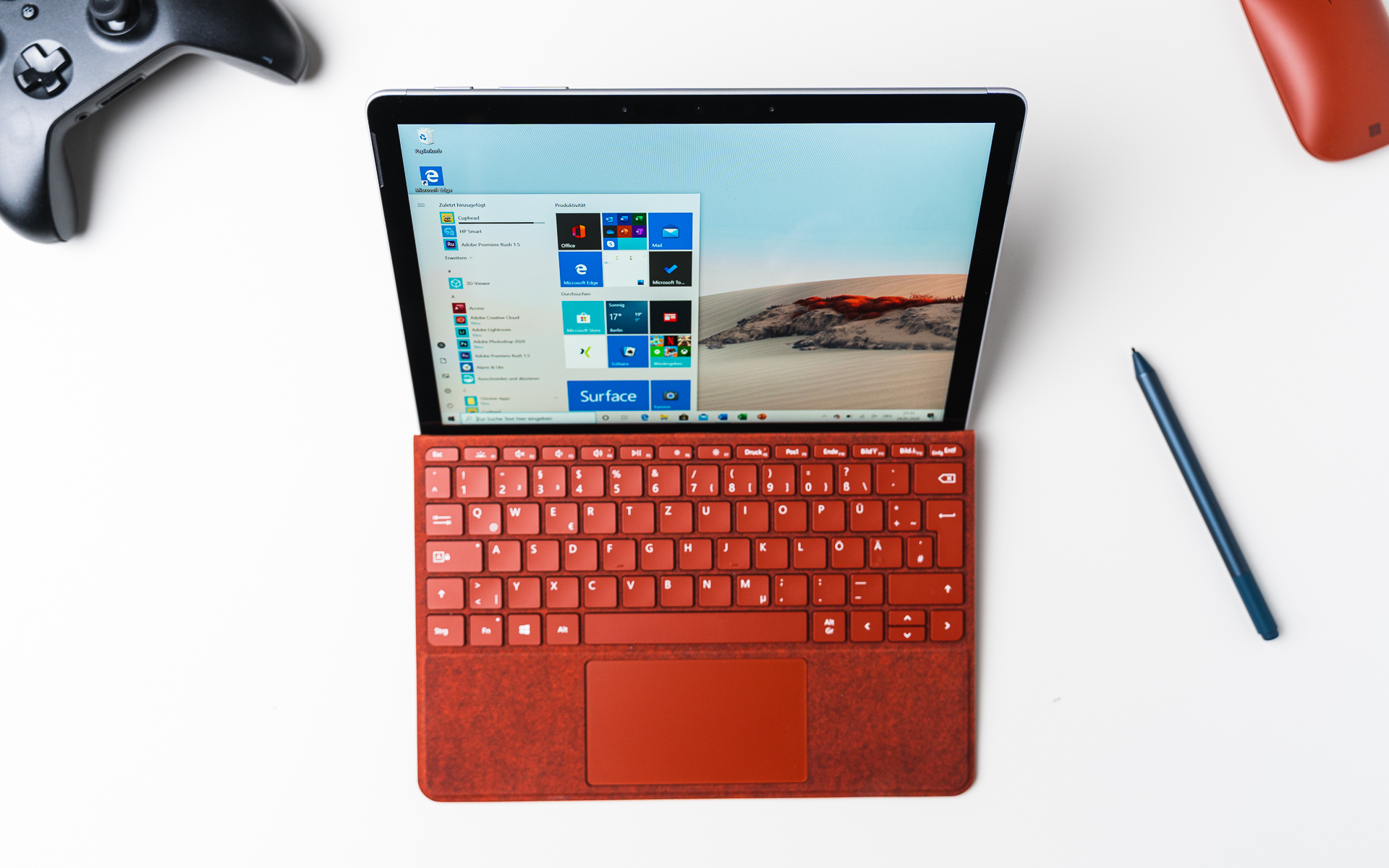
 The Best5 months ago
The Best5 months agoTop 3 Best Windows Tablets You Can Buy Today | 2024 Edition
-
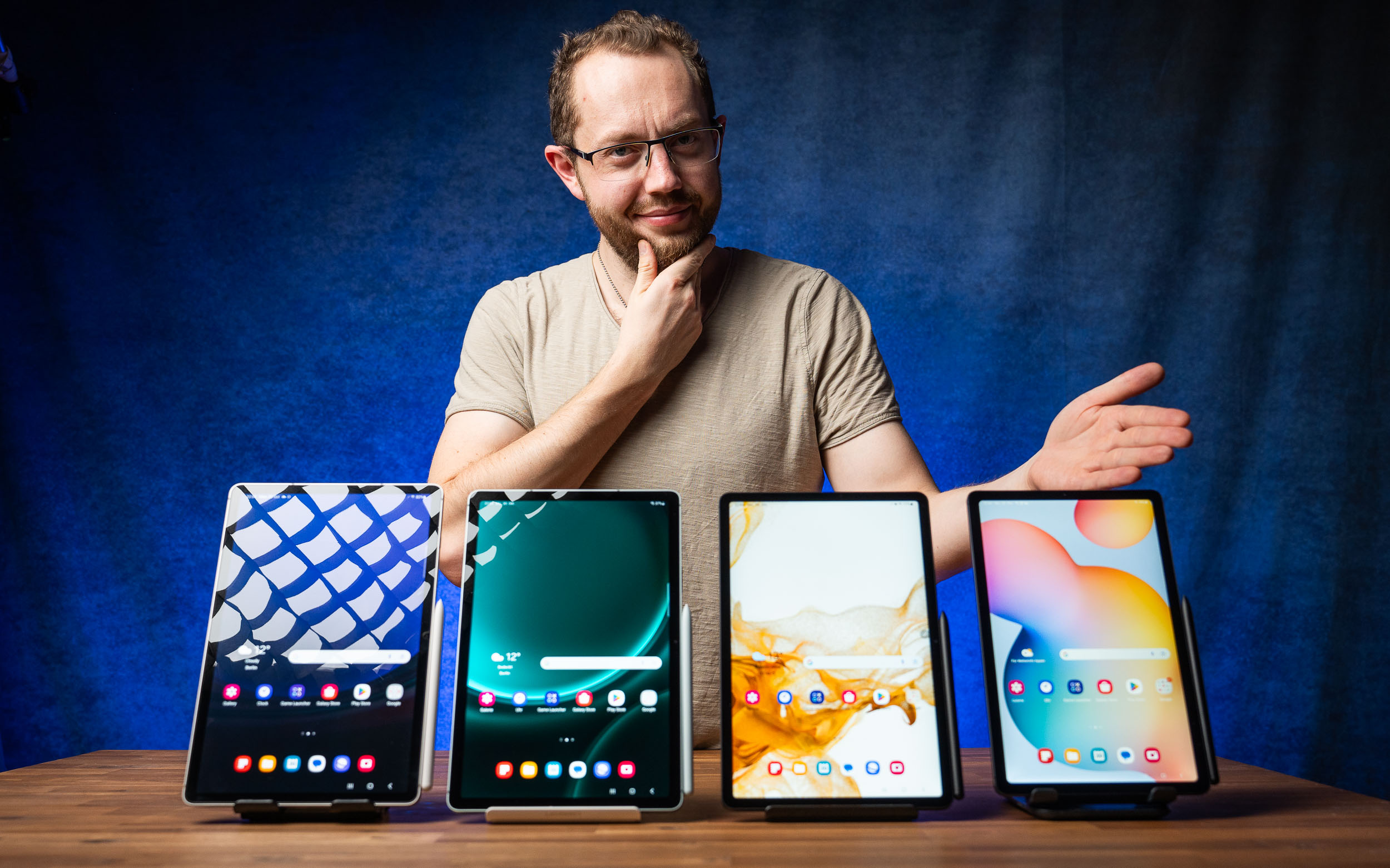
 The Best6 months ago
The Best6 months agoThe 8 Best Samsung Tablets: Our Big 2024 Comparison
-
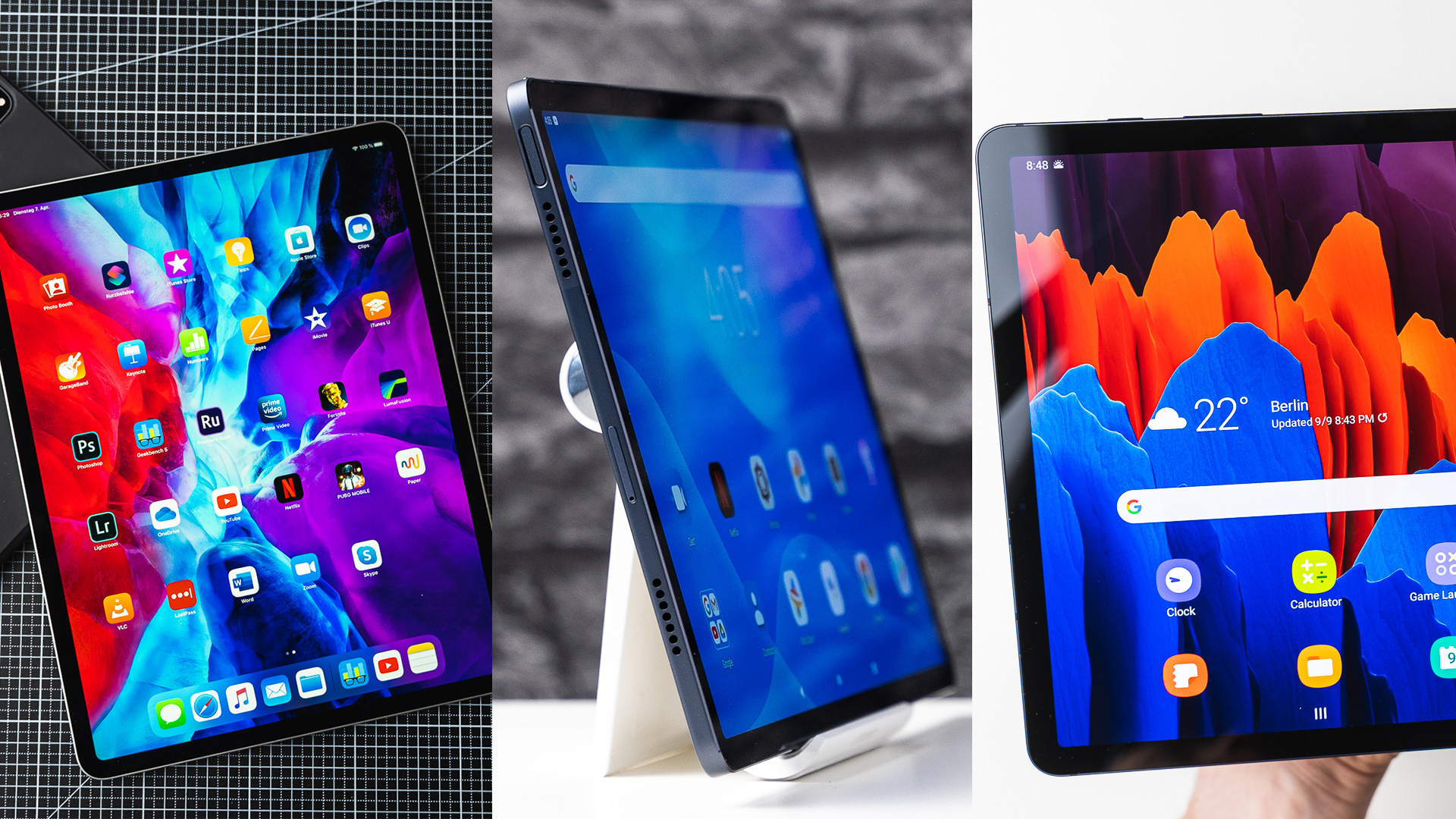
 The Best6 months ago
The Best6 months agoTop 7 Best Large Screen Tablets Tested | 2024 Edition

